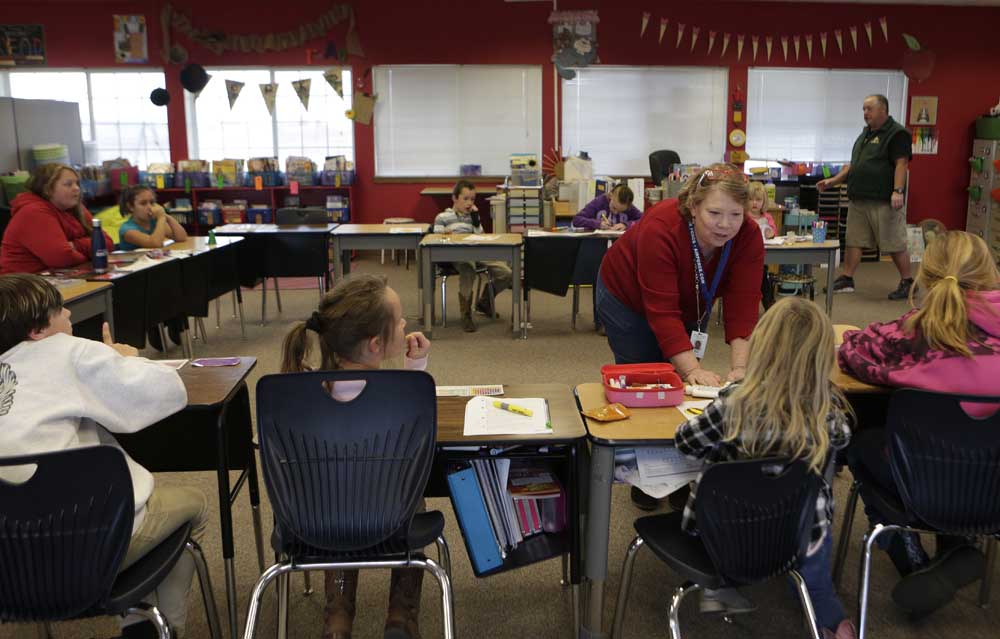Once-closed Brothers school is growing, needs a new well
Published 5:03 pm Friday, November 3, 2017

- Mona Boyd, the principal at Brothers School, works with students during class on Thursday, November 2, 2017. (Joe Kline/Bulletin photo)
Reopening Brothers Elementary School in the Crook County School District in fall 2015 has so far been a success. The district is looking to grow grass for a play field like its other schools have. But to do that, it will need more water.
Brothers Elementary has a play area with bark chips, but grass is sparse, if not nonexistent, so kids end up playing in the dirt.
“If they’re outside, they’re in the mud,” said Crook County School Board Chairman Doug Smith.
The school, in the small, unincorporated community of Brothers in eastern Crook County, operates on a well. The district needs to dig a well for there to be enough water at the school campus. In addition to providing water for the school, the well serves a small home where the Brothers Elementary teacher lives.
The well isn’t the only signifier of the tiny school’s rural nature.
Brothers Elementary School has one teacher, a principal who doubles as Crook County School District’s special education director, a part-time educational assistant who is also the elementary school’s secretary and a custodian/bus driver who oversees nutrition services.
The tiny school reopened in fall 2015 with five students.
The Brothers School District and the school had been closed since 2005.
The district had three students in the 2003-04 and 2004-05 school years and zero students going into the 2005-06 school year, according to Bulletin archives. Per state law, a school district in a county with more than 35,000 people must merge with an adjoining district if it has fewer than 18 students for two consecutive years. Last school year, Brothers had seven students, and this year it has 13. Pleased with how the school is operating, the Crook County School District intends to keep it open for the foreseeable future. The school being open saves students hours of commuting by bus.
To provide equal conditions for students across Crook County School District — a level playing field, of sorts — the school board realized it should plant grass for kids at Brothers Elementary.
The water at the school’s well is enough to serve the students and staff, but not enough to irrigate a lawn. On one test, the well was delivering about five gallons per minute. In comparison, one sprinkler head would spray about four gallons per minute. The field has about five sprinkler zones that would use about 30 gallons per minute each.
A specialist who checked out the well on Thursday told Leland Bliss, the Crook County School District’s facilities and safety supervisor, the school will need a new well. While the current one is 382 feet deep, a new well would be installed about 550 feet deep in a slightly different location.
The Crook County School Board approved the district spending up to $25,000 on a well without further board approval, but Bliss is hoping it won’t cost that much. He’s planning to open a request for proposals next month.
Bliss came to the Crook County School District from the Sisters School District in July 2016. Though that district is less than half the size of the Crook County School District, all of its schools run on city water. Last school year, Sisters School District had 1,087 students, while Crook County had 2,923, according to the Oregon Department of Education.
In the Crook County School District, Brothers isn’t the only school on a well: Paulina Elementary School and Powell Butte Community Charter School are on wells.
“I’m learning a lot about wells,” Bliss said, chuckling.
Smith said now that the reopening of the school has proved successful, it’s time the students receive a play field.
“We’ve done our experiment, and we know it’s going to stay open, and it’s a feasible model,” Smith said. “Now, we need to make sure we’re operating like a school needs to be operated.”
Running such a small school is expensive per student compared with larger ones. While the district’s nonrural elementary schools receive revenue of about $8,000 per student per year from the state per school year, Brothers receives about $27,000 per student with special rural school funding.
“The rural school funding addresses the problem that it costs more per student to operate a small school,” Anna Logan, the school district’s financial director, wrote in an email.
If a teacher costs $70,000 per year and has 25 students, that’s $2,800 per student to provide a teacher, Logan said. For a school with only five students, it would cost $14,000 per student, because the teacher costs the same amount.
Bliss hopes after putting out a request for proposals and finding a contractor, a new well could be installed in spring or summer. He would like to try planting seed to grow grass on the field.
— Reporter: 541-383-0325, kfisicaro@bendbulletin.com






